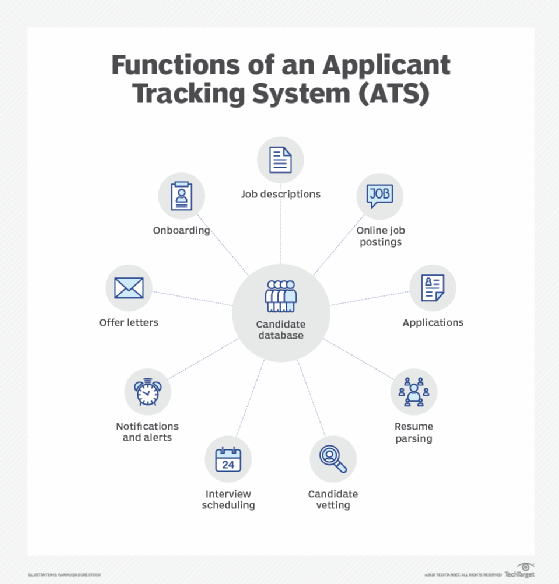
REDPIXEL - stock.adobe.com
10 common mistakes on resumes and how to avoid them
Strategic resume crafting is crucial for all job candidates. Focus on relevant information, avoid errors and emphasize your achievements.
Applying for positions in competitive tech sectors requires strategy, follow-through, research and consistent attention to detail.
Knowing something about how recruiting and hiring work can help ensure your resume is an effective and compelling calling card, backed up by your professional online presence. Most tech companies and large and mid-size employers use an AI-based applicant tracking system (ATS) to collect, screen and store information from resumes and application forms. Businesses might also use AI-based resume prescreening in a job search platform such as Indeed, where applicants have uploaded their resumes.
A 2024 Canva survey found that 57% of hiring managers prefer resumes with visuals versus all-text, and 71% expect text-based resumes to become obsolete in the next five years. With current capabilities, HR departments program their ATS for each search to find keywords and phrases, compile work history, and check other requirements, such as education and skills. This information can be used to screen out applications that lack required elements, or to present a ranking of resumes based on the programmed criteria.
Once the ATS screens resumes and moves qualified applications forward, a recruiter reviews them, quickly scanning for desirable characteristics as well as red flags. According to a 2024 study by ResumeLab, 64% of people making hiring decisions reported spending three to six minutes reviewing a resume.

"The resume should tell your story crisply within the first 30 seconds of review," said Robyn Pato, an HR leader and talent management specialist with more than 20 years in healthcare and other industries.
A resume and cover letter introduce you as a professional to a potential employer. A LinkedIn profile and activity, on the other hand, connects you with a network of professionals. This audience can include potential employers and recruiters but is more broadly made up of people with shared interests who follow you in your career. Pato said LinkedIn is an important job search tool but cautioned that an unprofessional profile photo can be detrimental.
LinkedIn profiles are less formal than resumes and can help round out a job applicant's story, said Marc Savino, an expert in talent acquisition and HR in high-growth tech start-ups. Recent active posting also demonstrates engagement and connection.
Avoid these common resume-writing mistakes
Resume problems include visually difficult presentation, language errors, information that should be there but isn't, and information that shouldn't be included but is. It might be useful to think of resume errors in two major categories: content and form.
1. The generic resume
Pato and Savino have both seen too many generic resumes, which are unpersuasive and require too much effort to read.
"When you're putting the resume together, you think of yourself. You list everything you've ever done. You're trying to sell yourself, but you need to tailor the resume for each position," Pato said.
A generic resume attempts to cast a wide net, but hiring managers want to see how your skills and work history are aligned with the specific position they're trying to fill. To avoid the generic resume problem, spend time compiling a master resume, including your full work history, accomplishments in each role and the skills you now bring to the table. Then devote additional time to analyzing posted job descriptions, identifying keywords and terms, and refining your professional story into a resume targeted specifically for that opportunity.
2. Missing contact information
Recruiters and hiring managers continue to receive resumes without applicants' essential contact information. Even if you've provided that information elsewhere in the application -- such as a cover letter or application form -- the resume document must include your name, phone number and personal email address. A mailing address might be included but is no longer a standard expectation. You might also choose to include relevant professional social media addresses as well, such as LinkedIn.
3. Too much irrelevant information
The generic resume is a prime example of this error, but even more targeted resumes can suffer from this problem. Stand out for your position-relevant qualifications and potential and don't sidetrack recruiters and hiring managers with irrelevant information. This includes information that might introduce bias -- such as age, marital or family status, and photo; grade-point average, unless it's your first job after college; hobbies or personal pursuits; and references, unless specifically requested.
Pato recommends including 10 years of experience on resumes. And rather than listing all the functions in each experience, identify your accomplishments in responsibilities that match or support the job description. Quantify achievements if possible, as numbers make them more concrete and tell a richer story. Emphasize experience-based skills that are identified in the job description.
4. Missing important information
You've listed your work title, place and dates of employment, and what you did there. But this doesn't tell the story of the outcomes and impact of your work; it doesn't provide the answer to: So what? Did you deploy tools, develop proficiencies and through your work support the organization's goals or mission? Say so. And remember to quantify your accomplishments.
Savino calls this a work story as opposed to a laundry list of skills. You need to know your strengths and share them. If you're stuck, get the perspective of a trusted co-worker or colleague to better understand your impact. Beyond the experience section, you should include professional development and learning opportunities, citing relevant post-degree learning, such as certificates, new technical skills and courses completed.
5. False or exaggerated claims
A 2023 ResumeLab study found that 70% of respondents have lied on a job application. But there are consequences if the lie is discovered, including how an employer deals with a breach of ethics.
Savino said he also sees more fake resumes -- many with AI fingerprints -- than he used to. While you need to do everything you can to stand out, it's important not to lie on your resume. Ensure all information -- including dates, titles, degrees and responsibilities -- accurately and truthfully represents you.
6. It takes too long to get to the good stuff
An HR professional's initial look at your resume takes in the top of the first page and scans the rest of it for headings and subheadings. If you haven't taken the reader through your targeted profile summary or objective and into your skills and experience in the page's top half, you've probably lost them.
Include your targeted profile summary or objective near the top of page 1, ensure skills are easy to find on that page and get in at least the most recent five years of experience, with appropriate bullet points for accomplishments and achievements.
7. Can't get through the ATS
Page formatting such as tables, graphics and text boxes can prevent some ATS from reading text, which means the human eye might never see the resume at all. Info in the header and footer might also be a problem.
Review the simple, ATS-compatible formats available at job search support sites such as Jobscan and Indeed. Stick with .docx or .pdf file types. You can also use a resume scanning service to test how well an ATS reads your resume.
8. Unclear/unusual order or labeling of elements
Unusual ordering of the main resume elements or using unusual names for them -- such as learning journey instead of education -- can confuse the ATS as well as the recruiter. Use the standard category names -- profile summary/objective, skills, experience and education -- and be eloquent and precise in populating the categories.
9. Bad page layout
Savino said readers can tell within five seconds if a resume is worth continuing to look at.
Avoid creating a resume that is sloppy, choppy and has no flow. A well-designed page practices principles including balance, consistency, adequate empty space, classic font at appropriate size -- such as Calibri, Arial, Helvetica and Times New Roman -- and rhythm in the use of bullets. These are all qualities meant to engage the reader and give quick, clear access to information.
10. Spelling and grammatical errors, typos and word choice
Errors in spelling, grammar and typing can take a reader's mind off the applicant's qualifications. Poor or incorrect word choice, using buzzwords and overusing keywords can be similarly distracting. Be sure to have someone proofread your final resume before sending it out. Some people do their own proofreading, and tools are built into MS Word to support this. And there are AI tools such as ChatGPT and Grammarly. A human proofreader who is not you can also provide their overall impression of your resume.
Victoria Liptak is a freelance content writer.







